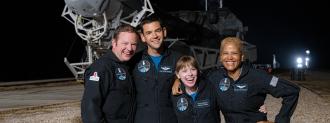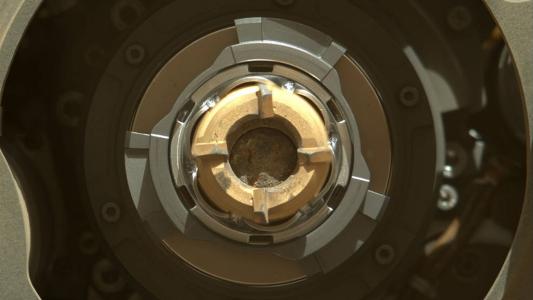Update, 9/20/21, 9:45 a.m. ET: The Crew Dragon spacecraft carrying the Inspiration4 astronauts safely splashed down in the Atlantic Ocean on September 18 at 7:06 p.m. ET.
Update, 9/16/21, 9:25 a.m. ET: The Inspiration4 mission launched as expected at 8:02 p.m. ET on September 15, bringing the number of people in space up to 14 — a new world record. The crew will remain in Earth’s orbit until September 18, at which point their Crew Dragon spacecraft will splash down in the Atlantic Ocean.
On September 15, a first-of-its-kind space mission is expected to launch from NASA’s Kennedy Space Center in Florida. Here’s why Inspiration4’s launch is important — and how you can watch as four amateur astronauts make history.
No pro astronauts allowed: In February, billionaire entrepreneur and experienced pilot Jared Isaacman announced that he had chartered a flight to Earth’s orbit via SpaceX. He dubbed the mission “Inspiration4” and announced plans to serve as its commander.
“I think people are going to look at as the first time everyday people could go to space.”
Jared Isaacman
Isaacman decided to donate the three remaining seats to civilians, making Inspiration4 the first mission to space without a professional astronaut onboard.
“I think when this mission is complete, people are going to look at it and say it was the first time everyday people could go to space,” Isaacman said in March, “and that’s important.”
“Someday in the future … you’re going to have a lunar base, you’re going to probably have some sort of a Martian colony, but you have to start somewhere,” he added.
The mission: During their time off-world, the Inspiration4 crew will collect medical data, recording their blood oxygen levels, heart rates, sleep quality, and more. They’ll also use an app to monitor for any changes in their cognition and behavior in space.
Researchers at the Translational Research Institute for Space Health (TRISH) will then use this information — as well as data recorded before and after the flight — to better understand how humans react to the space environment.
“This allows TRISH an opportunity to test new health and performance technologies for future NASA astronauts,” Jimmy Wu, TRISH’s senior biomedical engineer, explained.
The big picture: Isaacman hasn’t said what he spent on the Inspiration4 tickets, though estimates put them at about $50 million a pop.
Until the cost of space tourism drops significantly, it’s unlikely the average person is going to be making any jaunts into orbit, but Isaacman is hopeful that Inspiration4 will at least open people’s eyes to the fact that space is becoming more accessible.
“I could have just invited a bunch of my pilot buddies to go [on the flight], and we would have had a great time and come back and had a bunch of cocktails,” he told TIME in August.
“Instead,” he continued, “we wanted to bring in everyday people and energize everyone else around the idea of opening up spaceflight to more and more of us.”
The crew: Each Inspiration4 crew member represents one of the mission’s pillars: Leadership, Hope, Prosperity, and Generosity.
Cancer survivor Hayley Arceneaux, a physician assistant at St. Jude Children’s Research Hospital, represents Hope. At 29, she’s on track to be the youngest person to ever reach Earth’s orbit and the first with a prosthesis (it was implanted in her leg as part of her bone-cancer treatment).
Sian Proctor, a geoscience professor in Arizona, won the Prosperity seat through a contest demonstrating her use of Shift4Shop, an e-commerce platform owned by Isaacman’s company Shift4Payments — she’ll be the first person from Guam to visit space.
The Generosity seat is going to data scientist Chris Sembroski — he was gifted his ticket to space by a friend, who won it as part of a fundraising campaign for St. Jude’s.
As the mission’s commander, Isaacman will fill the Leadership slot himself.
The training: While none of the crew members are professional astronauts, they do have experience that could help them during the Inspiration4 mission.
Arceneaux has a medical background, and Sembroski is a former U.S. Space Camp counselor who served in the U.S. Air Force. Proctor, meanwhile, was a finalist during NASA’s 2009 Astronaut Selection Process and has completed four space simulation missions.
“[NASA] gives you two years to train for a mission. We [had] from March to September.”
Sian Proctor
Still, to prepare for the Inspiration4 mission, the crew had to complete a crash course in astronaut training.
“I’m used to doing things on NASA time, which gives you two years to train for a mission,” Proctor told TIME. “We have from March to September.”
During those months, the group hiked far up Mount Rainier, spent time in low-oxygen chambers, and spun around in human centrifuges. They also learned how to operate the mostly autonomous Crew Dragon spacecraft, in case something goes wrong during the mission.
Launch day: With the training behind them, all that’s left now is for the crew members to earn their astronaut wings.
A five-hour launch window for Inspiration4 will open at 8:02 p.m. EDT on September 15, with a backup window set for the following day at 8:05 p.m. EDT — either way, you’ll be able to watch along via a SpaceX livestream.
During the launch, a SpaceX Falcon 9 rocket will lift the Crew Dragon capsule carrying the four civilians into Earth’s orbit. They’ll then spend three days in space before splashing down in the Atlantic Ocean.
In addition to collecting medical data, the crew will also eat cold pizza, watch movies, and enjoy 360-degree views of Earth from an altitude higher than that of the International Space Station.
After the flight, several items brought into space during the mission — including a ukulele, a TIME magazine signed by the crew, and an NFT of a Kings of Leon song — will be auctioned off to raise money for St. Jude’s.
“One of the key things we’ve focused on since Inspiration4 was first announced was how we will be able to make a significant contribution to help St. Jude cure childhood cancer here on Earth,” Isaacman said. “Every item we are bringing is going to help us reach our goal and allow us to share this experience with so many others who want to offer support.”
We’d love to hear from you! If you have a comment about this article or if you have a tip for a future Freethink story, please email us at [email protected].






